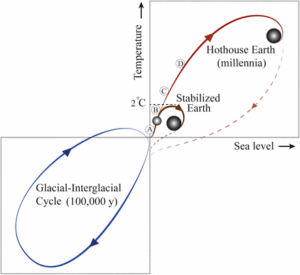Aug 09 2018
The Climate Tipping Point
 It’s now pretty clear that as we increase global CO2 levels in the atmosphere, mainly by burning stuff, global average temperatures have been increasing as well. This is predicted based upon the greenhouse effect of CO2 and other gases like methane, amplified by reactive gases like water vapor. The amount of warming that results from a given CO2 increase is called climate sensitivity (specifically the rise in average global temperature averaged over 20 years resulting from a doubling of atmospheric CO2), and there is some debate about exactly what the climate sensitivity is.
It’s now pretty clear that as we increase global CO2 levels in the atmosphere, mainly by burning stuff, global average temperatures have been increasing as well. This is predicted based upon the greenhouse effect of CO2 and other gases like methane, amplified by reactive gases like water vapor. The amount of warming that results from a given CO2 increase is called climate sensitivity (specifically the rise in average global temperature averaged over 20 years resulting from a doubling of atmospheric CO2), and there is some debate about exactly what the climate sensitivity is.
Without any feedback effects, from just the primary greenhouse effect of CO2 itself, climate sensitivity is about 1 degree C. However, there are feedback effects, meaning that rising temperatures affect the climate in such a way that more warming results. For example, if the polar icecaps reduce in size, they reflect less light back into space, which results in more warming. Current estimates of climate sensitivity are between 2 and 4.5 degrees C.
However, a new paper published in PNAS argues that climate sensitivity is not the only issue when it comes to predicting future climate change due to increased CO2. Those feedback loops do not only affect climate sensitivity – they also affect climate homeostasis. In other words, at any given amount of CO2 in the atmosphere, taking into consideration all the feedbacks in the climate, an equilibrium will be achieved. There are climate cycles around that equilibrium, but that equilibrium determines long term global average temperatures.
So – what we really need to do is determine where the new equilibrium will settle for any given amount of CO2. This requires predicting not only the effect of feedback loops on the climate, but their effect on each other. The authors argue that several feedback mechanisms can act like a domino effect – on feedback will increase temperatures enough to set off another feedback which increases temperature enough to set off yet another feedback. This whole chain has to work itself out before a new equilibrium is reached.
They are explaining the mechanism for a so-called tipping point (actually a cascade of tipping points), a point of no return. They ran their models and concluded that a temperature rise of 2 degrees C (above pre-industrial levels) will be enough to trigger this cascade. A new equilibrium point will not then be reached until global average temperatures rise 4-5 degrees C.
Some of the key feedbacks include forest dieback, loss of polar ice, decreased carbon sinks, and changes in bacterial respiration. Some of these are reversible, but others are not reversible on a human timescale. For example, there is carbon locked up in permafrost. If that permafrost melts, the carbon will be released, and that cannot be reversed anytime soon.
The effect of 4-5 degrees C temperature rise above pre-industrial levels would be disastrous. Estimates are this would raise sea levels by 10-60 meters, dramatically altering coastlines (you know – where most of our cities are). Some locations would have deadly heatwaves during the summer making them uninhabitable. Farmland would shift north. We would see more intense storms, and more wildfires.
This all sounds alarmist, and it is. It is alarmist in the same way as scientists warning about an asteroid they think is on a collision course with the Earth (to use Phil Plaits excellent analogy). There may be uncertainty about the orbital calculations, but if we are going to divert the asteroid it will take decades, so we have to do it now. Describing the devastation of the asteroid hitting is completely appropriate when advocating for preventive measures. Even if there were only a 1% chance of the asteroid hitting the Earth, I would think a rapid huge investment would be warranted to keep that from happening.
Climate scientists are about 95% confident that climate change is happening, due to human activity, and somewhere within the range of climate sensitivity above. I don’t know what the confidence is in this new analysis regarding a cascade of tipping points leading to a new hotter equilibrium point. The paper was just published, and we need time for the climate community to digest it and react. I hope they are wrong, but if the scientific consensus is that there is a reasonable probability they are right, we should act accordingly.
The authors emphasize the good news – if their models are correct, as alarming as they are, they also indicate that it is not too late. If we can limit post-industrial warming to 1.5 degrees C or less, we can avoid this cascade. This will probably not require some huge sacrifice, or government take-over of the economy as the global warming deniers alarmingly warn. It may only require that we enthusiastically embrace the future of green technology. I also think it means we need to embrace next generation fission power plants. We can argue about the details – but there are options available now to decarbonize our energy infrastructure.






